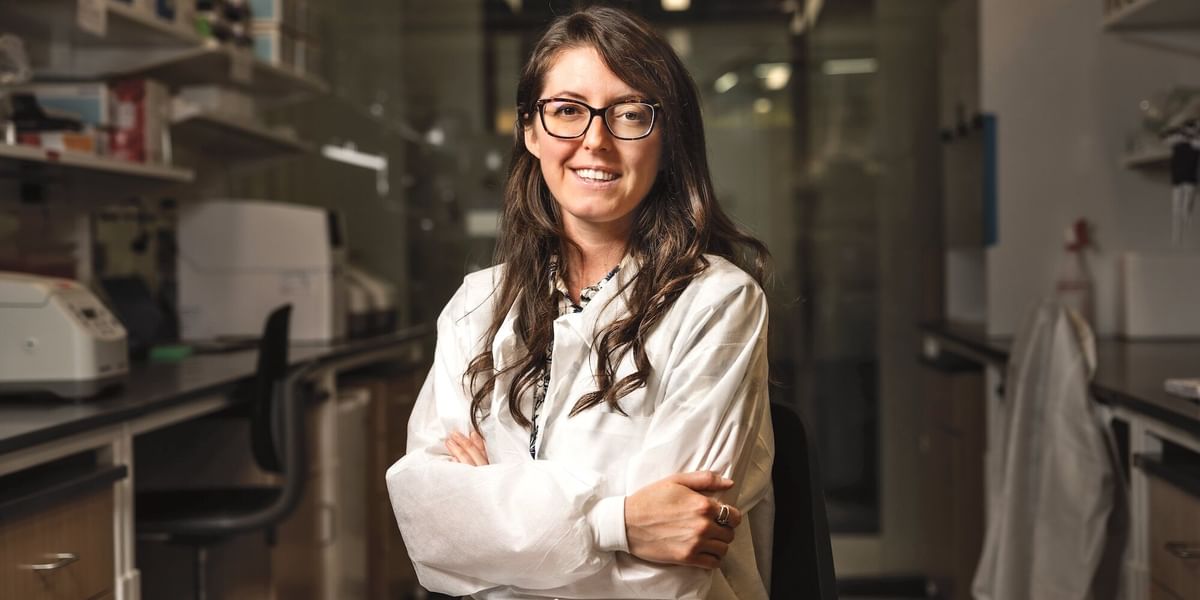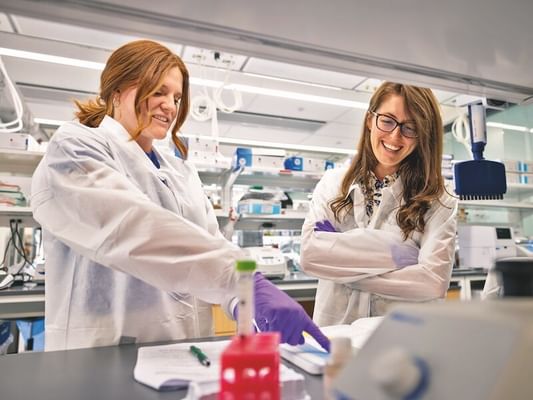- Undergraduate
Bachelor's Degrees
Bachelor of ArtsBachelor of EngineeringDual-Degree ProgramUndergraduate AdmissionsUndergraduate Experience
- Graduate
Graduate Experience
- Research
- Entrepreneurship
- Community
- About
-
Search
All Thayer News


Innovating for Women
Sep 16, 2024 | by Michael Blanding | Dartmouth Engineer
A mother's breast is a wonder of engineering. During nine months of pregnancy, it transforms into an organic factory producing a complex formula of fats, sugars, and protein antibodies that provides a baby exactly what it needs to thrive. "The entire mammary gland essentially grows like a new organ," says Dartmouth Engineering Professor Britt Goods Th'11. "At peak lactation, it can make a liter of milk a day."

Professor Britt Goods Th'11 studies systems biology with a focus on women's health. (Photo by Rob Strong '04)
That transformation is all the more amazing considering that most cells in the body are in it for themselves, not dedicated to churning out sustenance for another being. "Cells are selfish—they want to cut costs at all corners and maintain their own metabolism," says Goods, an assistant professor of engineering at Dartmouth. "It's fascinating we have these mini bio-reactors producing a tremendous amount of material."
Goods has long been fascinated by women's health issues, which historically have been woefully underexamined. Her approach is a practical one, looking to develop new approaches to medicine to keep women healthier and happier. "I am interested in taking engineering principles and systems-level thinking and applying them to solve problems in women's health," Goods says.
Lactation is just one focus. She also looks at contraceptives, working to develop new forms of birth control that do not rely on hormones, which cause side effects in many women. "We are trying to understand what sorts of things drive ovulation, because there is a real gap in the field," Goods explains. In addition, she is examining how female sex hormones such as estrogen and progesterone affect the immune system, looking particularly at macrophages, white blood cells that provide a critical line of defense against microbes and are used in treatment of diseases such as cancer.
"Using single-cell genomics, she has shown for the first time that these hormones have a distinct effect on specific macrophage subsets," says Patricia Pioli, associate professor of microbiology and immunology at Dartmouth's Geisel School of Medicine, who has collaborated with Goods on this research. "Her expertise in bioengineering uniquely positions her to use sophisticated technologies to parse the complexity underlying the distinction in immune responses between men and women."
In all of these areas, Goods' philosophy is simple: You can't make improvements in these complex biological systems until you understand them. "As an engineer, it's really hard to think about ways to turn the knobs and change things if you don't have a fully specified system."
Finding Her Path
Goods developed a passion for chemistry and biology in high school; even then, she was focused on making science useful. "I was never satisfied with just knowing the biological answer to something, I wanted to know how it could be used in an applied way," she says. Initially, she was interested in environmental engineering, and as a undergraduate at Colby College applied to Thayer's Partner School Dual-Degree Program, which allowed her to earned degrees in biochemistry from Colby and in engineering from Dartmouth. "I was fortunate enough to get into that program, and it set me on my path."
At Dartmouth, she worked with Professor Karl Griswold, who focused on high throughput screens for protein engineering, and shifted her focus from the outside world to the equally complex environment within the human body. After graduation, she went on to earn a PhD at MIT examining diseases of the central nervous system such as multiple sclerosis and brain cancer.
As a postdoc, something happened that completely changed the course of her research—she became a mother. As she observed the many changes happening in her own body, she began digging into literature to better understand them—and ultimately found little to satisfy her. "I wanted to know more about this and did not see it prioritized in the way I had seen other areas," she says. She made a decision to change that. "I was like, I'm a scientist, I could do this—and I did."
Not that it was easy. As a postdoc, Goods remembers going to pitch competitions with a proposal to study endometriosis, a painful disease of the uterus. "I can't tell you the number of times people were like, 'Have you thought about prostate cancer?'" she says. "Meanwhile, there is nothing in this space, and it affects up to one in 10 women."
She persevered, joining MIT's Milk Study to examine the unique components of human milk. That presented its own difficulties, as she dealt with the challenges of obtaining fresh samples from lactating mothers. "As you can imagine, it's not easy to get lactating women to give you some of their breast milk," says Goods, who collected samples wherever she could, picking up coolers from front porches and mailboxes and waiting outside women's offices while they pumped. "There are some pretty unique constraints, and we wanted to be super-flexible for that."
Eventually, her lab built foundational datasets, tracking how breast milk changes through time as the breast itself changes—work she has continued since returning to Thayer as a professor in 2021.

Working in the Goods Lab. (Photo by Rob Strong '04)
Making Milk "Salad"
Breast milk is an incredibly complex substance that remains little understood by scientists. It contains more than 200 unique sugars, only a handful of which have been reproduced adequately in the lab, along with living cells and immune factors that seem to change in response to signals from the nursing infant. "It's a living fluid that responds to infant needs through this bio-directional communication," Goods says.
In her work, Goods often uses a technique called transcriptomics, which analyzes all of the RNA in a sample to understand how genes are being expressed and what proteins it might produce. "It's a really powerful way to assess what a cell is currently doing," she says. On a bulk level, she compares it to "taking a salad and putting it into a blender." But it can also be done on a single-cell level, which is more like examining each element of the "salad" in turn. "You might have different-colored carrots or lettuce of different shapes and sizes," Goods explains. "You can really specify the system in a way you can't with these bulk measurements."
In her ongoing project on lactation, Goods Lab is working to map specific genes onto the production of the many unique sugars in human breast milk. Among other discoveries, she has found an increase through time in epithelial cells located along the lobules where milk is produced that seem to change to produce different types of sugars. "There's a pretty big diversity of these epithelial cells that make milk, and now we have some thoughts about how they divide and how they may be functionally distinct," she says.
Ultimately, her findings could lead to bioengineering of synthetic formula that more closely mimics the unique qualities of human breast milk. Although she believes natural milk is best for babies, Goods acknowledges there are many reasons why that may not be possible for some women. "Our society is not set up to support breastfeeding securely," she says. "There need to be more options for people that are closer to what people get naturally." By understanding what's happening on a genetic level, she imagines a world in which synthetic milk could be biologically engineered for specific properties. "The 10-year vision is to see if we can actually create on-demand nutrition, using the proportion of different cells to inform the creation of the end product."
Contraceptives and Cancer
Goods uses similar techniques of single-cell transcriptomics in her work on non-hormonal contraception to understand what is happening inside the ovaries when they produce eggs. She also uses a more advanced technique called spatial transcriptomics, which allows a researcher to better examine where specific components exist in space. To continue the salad analogy, it's like looking where individual vegetables are in the mix, "like how all the carrots fall to the bottom," Goods says.
These techniques allow her lab to examine the full process behind production of eggs in the ovaries an implantation in the uterus. "About 40 percent of women who start with hormonal birth control stop in the first year because of the significant side effects," she says. The goal is to find a place where a gene could be switched on or off to interrupt the process, thus preventing pregnancy without those side effects. "The dream is to be able to see a target that I discovered in my lab ultimately translated into the clinic for family planning purposes" in the form of a pill or other therapeutic, says Goods, who is pursuing the goal along with a group of researchers called the Ovarian Contraceptive Discovery Initiative. "It's a really hard problem from a drug development standpoint, but it looks like we'll get there. So that’s exciting."
Her last line of research involves the immune system, which some evidence shows differs in men and women as a result of interactions between blood cells and female sex hormones. As with other issues in women's health, these interactions have been poorly studied in the past. "It makes it really hard to engineer strategies for these cells, because you are going to alter their behaviors based on local signals from these sex hormones," Goods says.
Her work includes taking human blood cells called monocytes and using a "special sauce" to turn them into macrophages, the white blood cells that attack and eat harmful microbes in the blood. They also play a critical role in attacking cancer tumors, and some cancer therapies involve engineering special macrophages carrying anti-cancer drugs to augment that process. Goods is hoping to determine how to best engineer such cells to take into the account the impact of sex hormones so they can be more effective.
In her work, Goods has come full-circle, working with undergraduates at Thayer, where she took her first engineering classes more than a decade ago. These students serve as study coordinators obtaining samples for a local milk bank for the lactation research. "It's been a lovely way to get them trained in how to do human subjects research," she says. Just as her hands-on research took her in different areas to find her lab's focus on women's health, it is crucial as undergrads figure out their own paths, she says. "It can not only help you learn skills but also help you learn the things you like and don't like," says Goods. "When I think about my own meandering path to where I am now, these opportunities are incredibly important."
In the years since she has started working on bioengineering and women's health, Goods has been happy to see interest in the area increase. She hopes to inspire more scientists to work in the field, where so many discoveries remain to be made. "I have to acknowledge those who have come before me in this field, and worked really hard to make it a priority," she says. "I hope that the trend continues—because there is so much to do here."
For contacts and other media information visit our Media Resources page.
